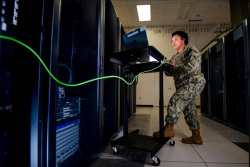Despite demand, DISA financially constrained to scale cloud capabilities overseas

The Defense Information Systems Agency is conducting a number of pilots to provide commercial cloud capabilities to warfighters outside of the continental United States. But a lack of available funding has slowed the expansion of those services to more locations and users, an agency official said.
In 2023, DISA began its Joint Operational Edge (JOE) initiative, envisioned as an integrated mesh of edge computing platforms located at Defense Department sites that could provide cloud capabilities overseas. The agency then launched different beta programs to test and scale its OCONUS cloud offerings, one of which is a version of the Stratus private cloud capability at Joint Base Pearl Harbor-Hickam in Hawaii in support of operations in Indo-Pacific Command’s area of responsibility.
Col. Jeffrey Strauss, DISA’s acquisition deputy for programs, said that while the overall effort is going well — with one of the OCONUS cloud offerings already being used to its maximum capacity — the agency is competing for funds to do more.
“There is a demand [and] appetite to do more and to prototype some new ones,” Strauss told DefenseScoop on Friday during an event hosted by Washington Technology. “The challenge there is we don’t have a lot of free capital for DISA to invest if we don’t know we have a customer.”
Part of the strain comes from the large amount of infrastructure and capability that DISA must allocate money towards maintaining, Strauss explained. A significant portion of the agency’s annual budget is eaten up by operation-and-maintenance funding to sustain current ops, which restricts how much money it can dedicate to new investment in its research-and-development portfolio, he said.
For example, DISA requested $2.6 billion in its O&M budget for fiscal 2025 and just $258 million for R&D projects.
“When you have this big sustainment bill and it grows, what gets pressured is investments into new things,” Strauss said.
As a combat support agency to the entire Defense Department, DISA also receives money from the other components via the Defense Working Capital Fund, a type of revolving pot of money that supports buying and selling of services across the Pentagon. Individual agencies put a portion of their budgets into the fund, which is then used by DISA to perform the specific services that others order from them.
Strauss indicated that although DISA hears the demand for OCONUS cloud capabilities from the military services, that doesn’t necessarily translate into what they provide financially — creating another barrier in deploying more cloud capabilities outside of the United States, he said.
In a separate interview with DefenseScoop, DOD’s Chief Information Officer John Sherman noted that OCONUS offerings weren’t initially part of the Pentagon’s push to deploy enterprise cloud capabilities under the Joint Warfighting Cloud Capability (JWCC).
However, there was recognition that future operations in the vast distances of the Indo-Pacific might require additional infrastructure, he said.
“JWCC’s infrastructure is in the continental United States, and the cloud service providers have edge capabilities that you could carry around in a [Joint Light Tactical Vehicle] or maybe even a personal portable sort of thing,” Sherman said Wednesday on the sidelines of the GEOINT Symposium in Florida. “There’s a real tyranny of distance from the Marianas Islands all the way back to California or Arlington, Virginia. You need a lily pad somewhere so you don’t have to backhaul the information.”
The larger JOE program is tackling how to provide those cloud capabilities to warfighters operating in remote locations. Along with the initial prototypes for Indo-Pacom, Sherman said his office is already looking at other deployment options in the Western Pacific, Europe and elsewhere.
“Part of this is cloud tradecraft. We’re learning this as we go along here with the intelligence community to figure out how to do cloud capabilities from the continental United States out to the tactical edge,” he said. “JOE cloud is one of those things we’ve learned that we need in place to have that sort of connectivity.”
DefenseScoop reporter Brandi Vincent contributed to this story.






